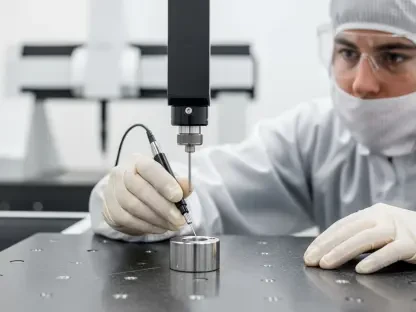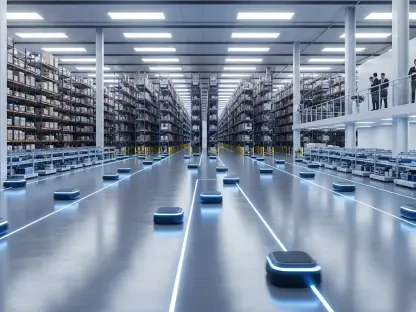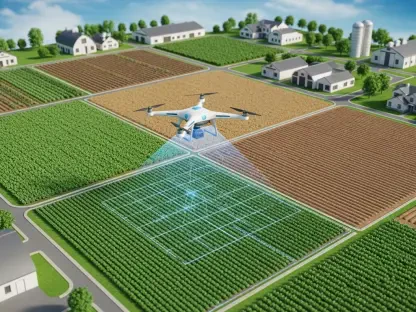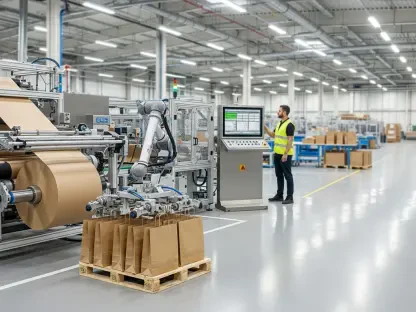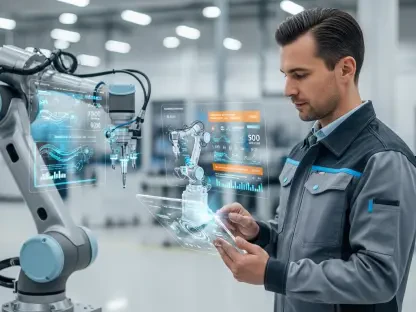Imagine a factory floor where robots not only perform repetitive tasks but also adapt to their surroundings in real time, identifying objects and navigating complex environments with minimal human input. This vision of seamless industrial automation is becoming a reality with ABB Robotics’ latest innovation, a groundbreaking software solution designed to enhance robotic autonomy. Debuted at the 25th China International Industry Fair in Shanghai, this cutting-edge technology equips ABB’s OmniCore-powered robots with advanced vision capabilities through integration with third-party cameras and sensors. The result is a significant leap forward in enabling robots to interact dynamically with diverse settings, opening up new possibilities across industries like manufacturing, logistics, and food and beverage. This development signals a transformative shift, promising to redefine efficiency and adaptability in industrial operations by empowering robots to handle increasingly intricate tasks with unprecedented independence.
Revolutionizing Robot Interaction with Advanced Vision
The core strength of this new software lies in its ability to enable robots to perceive and respond to their environments instantaneously. By leveraging sophisticated vision technology, the system allows ABB’s robots to recognize objects, assess surroundings, and make decisions without constant human oversight. This capability is particularly impactful in sectors requiring precision, such as automotive and electronics manufacturing, where tasks like item sorting and quality inspection demand high accuracy. The software’s integration with external sensors ensures that robots can adapt to varying conditions, enhancing their versatility across different applications. This marks a pivotal advancement in reducing dependency on pre-programmed responses, allowing for more fluid and responsive operations that can keep pace with the dynamic needs of modern production lines. As industries increasingly prioritize flexibility, this technology offers a robust solution to meet those evolving demands with smarter, more intuitive robotic systems.
Beyond its technical prowess, the software dramatically streamlines the setup process for robotic systems, making advanced automation more accessible. Featuring a user-friendly drag-and-drop web interface, it caters to operators of varying skill levels, eliminating the need for extensive programming expertise. Commissioning time is reduced by up to 90% compared to traditional custom solutions, thanks to rapid image acquisition and recognition capabilities. Furthermore, seamless compatibility with ABB’s RobotStudio programming and simulation tool facilitates quick deployment, minimizing downtime during integration. For more complex operations, pairing the software with ABB’s Automatic Path Planning Online optimizes collision-free paths, slashing cycle times by up to 50%. This focus on efficiency and ease of use underscores a broader industry trend toward democratizing robotics, ensuring that businesses of all sizes can harness cutting-edge technology to boost productivity without prohibitive barriers to entry.
Driving the Future of Autonomous Versatile Robotics
ABB’s introduction of this vision-enhancing software represents a cornerstone in its ambitious pursuit of autonomous versatile robotics (AVR). The company envisions a future where robots can independently execute complex tasks by combining advancements in vision, precision, speed, dexterity, and mobility, all underpinned by generative AI. This strategic direction aims to eliminate the need for human intervention in intricate processes, paving the way for fully autonomous systems capable of tackling unpredictable challenges. The software serves as a critical milestone in this journey, demonstrating how sensory perception can transform robotic functionality across diverse industrial landscapes. By prioritizing autonomy, ABB is not only enhancing operational capabilities but also redefining the role of robots as indispensable partners in achieving higher efficiency and innovation in workplaces worldwide, setting a new standard for what automation can achieve.
Complementing internal innovation, ABB’s commitment to advancing robotic autonomy is bolstered by strategic collaborations that amplify its technological edge. A notable partnership with LandingAI, a firm specializing in vision AI, focuses on making such technologies more intuitive and accessible. This collaboration has the potential to cut training and deployment times by up to 80%, empowering system integrators and end users to independently retrain AI for new scenarios. Such flexibility ensures that robotic systems can adapt to changing requirements without extensive reconfiguration, a vital advantage in fast-paced industries. This synergy between internal development and external partnerships highlights ABB’s forward-thinking approach, positioning it as a leader in integrating AI-driven solutions into robotics. The emphasis on adaptability through collaborative efforts reflects an industry-wide shift toward smarter systems that can evolve alongside emerging needs and technological advancements.
Leadership and Industry Impact in Robotics Innovation
ABB Robotics stands as a titan in the global robotics landscape, with a presence in 53 countries and a workforce of approximately 11,000 dedicated professionals. Renowned as a leading provider of industrial robots and autonomous mobile robots (AMRs), the company continues to shape the trajectory of automation through consistent innovation. The planned spin-off of ABB Robotics from its parent group, announced earlier this year, underscores the division’s critical importance and potential for independent growth. Additionally, ABB’s active engagement in industry events, such as upcoming discussions on AI-driven robot performance enhancements at RoboBusiness, illustrates its commitment to sharing knowledge and driving progress. By fostering dialogue and collaboration, ABB reinforces its role as a catalyst for advancements that benefit the broader robotics community, ensuring that emerging technologies translate into tangible improvements across various sectors.
The growing integration of AI and vision technologies in robotics, as exemplified by ABB’s latest software, signals a transformative era for industrial automation. These technologies are increasingly recognized as essential for boosting efficiency, adaptability, and autonomy in robotic systems, enabling them to navigate complex and dynamic environments with ease. Specific applications of the software, such as enhancing item sorting and quality control, showcase its versatility in addressing critical needs in industries ranging from packaging to logistics. This alignment with broader industry trends toward smarter, more independent systems positions ABB at the forefront of a robotics revolution. By prioritizing the fusion of AI and sensory capabilities, the company is helping to create a future where robots are not just tools but intelligent collaborators capable of meeting the sophisticated demands of modern production with precision and reliability.
Reflecting on a Milestone for Industrial Automation
Looking back, the unveiling of ABB’s vision-enhancing software marked a defining moment in the evolution of industrial robotics. It showcased how far the field has come in enabling machines to interact intelligently with their environments, setting a benchmark for efficiency and autonomy. The drastic reduction in setup times through intuitive interfaces and the seamless integration with existing tools have already begun to reshape operational workflows across multiple sectors. Strategic partnerships, such as with LandingAI, have further accelerated the adoption of AI-driven solutions, proving that collaboration is key to overcoming technological barriers. As the industry reflects on this advancement, the focus shifts toward future scalability—how these innovations can be expanded to empower even more businesses with accessible, autonomous systems. The path ahead involves continuous refinement and broader application, ensuring that the potential of smarter robotics is fully realized in solving tomorrow’s challenges.


